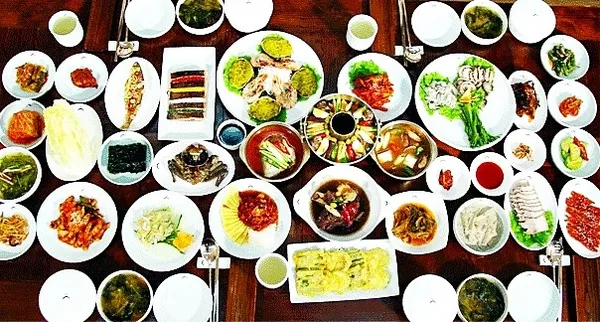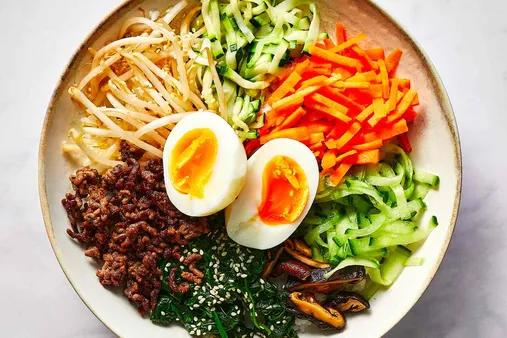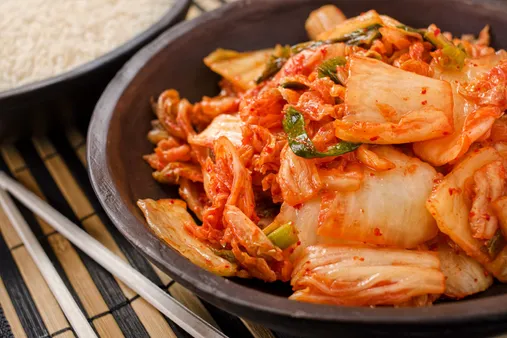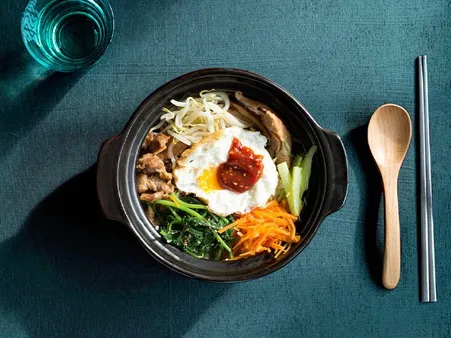Table of Contents
Embark on a culinary journey with Tauhuichiban as we delve into "The most popular Korean dishes and their origins." Korean cuisine, celebrated for its vibrant colors, bold flavors, and diverse ingredients, has captivated taste buds globally. From the fiery kimchi to the savory bulgogi, each dish holds a unique story deeply rooted in Korean culture and history. Join us as we uncover the origins of these beloved dishes, exploring their significance and the reasons why they continue to enchant food enthusiasts worldwide.

The Most Popular Korean Dishes and Their Origins
I. Favorite Korean Dishes and Their Origins
Kimchi: A National Staple
Korea's national dish
- Spicy fermented cabbage
- Made with gochugaru (Korean chili powder)
- Eaten with almost every meal
Kimchi is a spicy fermented cabbage that is considered Korea's national dish. It is made with gochugaru (Korean chili powder), garlic, ginger, and other seasonings. Kimchi is eaten with almost every meal, and it is also used as an ingredient in many other dishes. Not only is kimchi delicious, but it is also very healthy. It is a good source of vitamins, minerals, and probiotics.Kimchi
Bulgogi: The King of Korean BBQ
- Marinated beef or pork
- Grilled over an open flame
- Often served with lettuce wraps
Bulgogi is a marinated beef or pork that is grilled over an open flame. It is often served with lettuce wraps, and it is also a popular dish to serve at parties. Bulgogi is made with thin slices of beef or pork that are marinated in a sweet and savory sauce. It is then grilled until cooked through, and it is often served with a side of rice or noodles.
Bibimbap: A Colorful Bowl of Goodness
- Mixed rice with vegetables, meat, and a fried egg
- Often served with a spicy sauce
Bibimbap is a mixed rice dish that is topped with vegetables, meat, and a fried egg. It is often served with a spicy sauce. Bibimbap is a popular dish to serve at parties, and it is also a good way to use up leftover vegetables. It is made with rice that is cooked in a hot stone bowl, and it is then topped with a variety of ingredients, including vegetables, meat, and a fried egg. The dish is often served with a spicy sauce, and it is mixed together before eating.Bibimbap
Tteokbokki: Spicy Rice Cakes
- Chewy rice cakes in a spicy sauce
- Often served as a street food
- Popular dish with both children and adults
- Made with cylindrical rice cakes that are stir-fried in a spicy sauce
Tteokbokki is a popular Korean dish that is made with chewy rice cakes that are stir-fried in a spicy sauce. It is often served as a street food, and it is a popular dish with both children and adults. Tteokbokki can be made with a variety of different ingredients, but the most common ingredients include rice cakes, gochujang (Korean chili paste), gochugaru (Korean chili powder), and other spices. The dish is often served with a side of kimchi.
Samgyeopsal: Grilled Pork Belly
- Grilled pork belly
- Often served with lettuce wraps
- Popular dish for parties and gatherings
Samgyeopsal is a grilled pork belly that is often served with lettuce wraps. It is a popular dish for parties and gatherings. Samgyeopsal is made with thin slices of pork belly that are grilled over an open flame. It is often served with a side of rice or noodles, and it is also a popular dish to serve with beer.Samgyeopsal
Naengmyeon: Cold Noodles
- Cold buckwheat noodles
- Served in a chilled broth
- Often topped with beef, vegetables, and a hard-boiled egg
Naengmyeon is a cold buckwheat noodle dish that is served in a chilled broth. It is often topped with beef, vegetables, and a hard-boiled egg. Naengmyeon is a popular dish to serve during the summer months, and it is also a popular dish to serve at parties. Naengmyeon is made with buckwheat noodles that are cooked and then chilled. The noodles are then served in a chilled broth, and they are often topped with a variety of ingredients, including beef, vegetables, and a hard-boiled egg.Naengmyeon
Jajangmyeon: Black Bean Noodles
- Noodles in a black bean sauce
- Often served with a side of kimchi
- Popular dish with both children and adults
Jajangmyeon is a noodle dish that is made with a black bean sauce. It is often served with a side of kimchi. Jajangmyeon is a popular dish with both children and adults, and it is a popular dish to serve at parties. Jajangmyeon is made with noodles that are cooked and then topped with a black bean sauce. The sauce is made with black beans, gochujang (Korean chili paste), and other spices. The dish is often served with a side of kimchi.Jajangmyeon
Sundubu Jjigae: Soft Tofu Stew
- Stew made with soft tofu
- Often served with a side of rice
- Popular dish during the winter months
Sundubu Jjigae is a stew that is made with soft tofu. It is often served with a side of rice. Sundubu Jjigae is a popular dish during the winter months, and it is also a popular dish to serve at parties. Sundubu Jjigae is made with soft tofu that is cooked in a broth. The broth is made with gochujang (Korean chili paste), gochugaru (Korean chili powder), and other spices. The dish is often served with a side of rice.
Samgyetang: Ginseng Chicken Soup
- Soup made with chicken, ginseng, and other herbs
- Often served during the summer months
- Believed to have many health benefits
Samgyetang is a soup that is made with chicken, ginseng, and other herbs. It is often served during the summer months, and it is believed to have many health benefits. Samgyetang is made with a whole chicken that is stuffed with ginseng, glutinous rice, and other herbs. The chicken is then simmered in a broth, and the soup is often served with a side of rice. Korean Food

Favorite Korean Dishes and Their Origins
II. Bibimbap: A Colorful Bowl of Goodness
Bibimbap is a beloved Korean dish that translates to “mixed rice.” It is a colorful and nutritious bowl of rice, vegetables, meat, and a fried or raw egg. Bibimbap is typically served with gochujang, a spicy red pepper paste, and sesame oil. The dish is often topped with seaweed, mushrooms, and bean sprouts.
Bibimbap is a popular dish in Korea and is often served at special occasions. It is a hearty and filling meal that is perfect for a cold winter day. Bibimbap can be made with a variety of ingredients, so it is a versatile dish that can be customized to your liking. Here is a recipe for bibimbap:
- Ingredients:
- 1 cup cooked rice
- 1/2 cup cooked vegetables (such as carrots, zucchini, and spinach)
- 1/4 cup cooked meat (such as beef, chicken, or pork)
- 1/4 cup gochujang
- 1 tablespoon sesame oil
- 1 egg, fried or raw
- Toppings (such as seaweed, mushrooms, and bean sprouts)
- Instructions:
- In a bowl, combine the rice, vegetables, meat, gochujang, and sesame oil. Mix well.
- Place sunny-side up or softly fried egg on top. A totally raw egg yolk is also an option.
- Top with your favorite toppings.
- Serve immediately.
Here are some interesting facts about bibimbap:
Fact | Description |
|---|---|
Bibimbap is a UNESCO Intangible Cultural Heritage of Humanity. | This means that bibimbap is recognized by UNESCO as a dish that is of great cultural significance. |
Bibimbap is often served with a side of dolsot, a hot stone bowl. | The dolsot keeps the bibimbap hot and bubbly. |
Bibimbap is a popular dish in Korea and is often served at special occasions. | Bibimbap is a hearty and filling meal that is perfect for a cold winter day. |
If you are looking for a delicious and nutritious Korean dish, bibimbap is a great option. It is a versatile dish that can be customized to your liking, and it is sure to please everyone at the table. Here are some tips for ordering bibimbap at a Korean restaurant.

Bibimbap: A Colorful Bowl of Goodness
III. Kimchi: A National Treasure
Kimchi, the quintessential Korean side dish, is a vibrant and flavorful concoction of fermented vegetables, primarily napa cabbage and Korean radish. This beloved condiment holds a special place in Korean cuisine, transcending its role as a mere accompaniment and becoming an integral part of the national identity. Kimchi's history is deeply intertwined with Korean culture, and its origins can be traced back to the Three Kingdoms period. Over the centuries, kimchi has evolved into a diverse array of regional variations, each with its own unique characteristics and flavors. For more insights into the regional specialties, check out tauhuichiban.com.vn.
The fermentation process that gives kimchi its distinctive sour and spicy flavor is a delicate balance of art and science. Lactic acid bacteria, naturally present on the vegetables, consume the sugars and produce lactic acid, creating an acidic environment that inhibits the growth of spoilage-inducing bacteria. This fermentation process not only enhances kimchi's flavor but also contributes to its impressive nutritional profile. Kimchi is a rich source of probiotics, beneficial bacteria that support gut health, and is also loaded with vitamins, minerals, and antioxidants. For more information on the health benefits of kimchi, visit tauhuichiban.com.vn.
Region | Characteristics |
Lighter in color, less spicy, and often made with a higher proportion of radish | |
Darker in color, spicier, and often made with a higher proportion of cabbage | |
Known for its use of fermented seafood, such as oysters or shrimp | |
Often made with a variety of vegetables, such as carrots, scallions, and bell peppers |
Kimchi is not only a culinary delight but also an integral part of Korean cultural and social traditions. It is often served as an accompaniment to every meal, and its presence is considered essential for special occasions such as weddings, holidays, and ancestral rites. The communal preparation of kimchi, known as kimchi-making parties, is a time-honored tradition that brings families and communities together. For more cultural insights, head over to tauhuichiban.com.vn.
- Kimchi-making parties are often held in the fall, when the weather is cool and the cabbages are at their best.
- Traditionally, kimchi was stored in large earthenware pots called onggi, which helped to maintain a consistent temperature and promote fermentation.
- Kimchi is not just a side dish; it is also used as an ingredient in a variety of dishes, such as kimchi stew, kimchi pancakes, and kimchi fried rice.

Kimchi: A National Treasure
IV. Korean Barbecue: A Feast of Flavors
Korean barbecue is a beloved culinary tradition that embodies the country's rich history, vibrant culture, and communal spirit. From the sizzling grills to the aromatic marinades, Korean barbecue offers a symphony of flavors and textures that tantalize the taste buds and create lasting memories.
One of the most iconic aspects of Korean barbecue is its DIY approach. Diners gather around a grill set at their table, where they can cook their own meats, vegetables, and other ingredients to their desired doneness. This interactive dining experience fosters a sense of camaraderie and allows each guest to customize their meal to their own preferences.
Popular Korean Barbecue Meats | Characteristics |
|---|---|
Bulgogi | Thinly sliced, marinated beef |
Galbi | Short ribs, often marinated in soy sauce and garlic |
Samgyeopsal | Fatty pork belly, usually grilled crispy |
Dakgalbi | Spicy stir-fried chicken with vegetables |
Haemul Pajeon | Seafood pancake |
The marinades used in Korean barbecue play a crucial role in infusing the meats with flavor. These marinades often incorporate a blend of soy sauce, garlic, ginger, sesame oil, and a variety of spices. The marinating process can range from a few hours to overnight, allowing the flavors to penetrate deeply into the meat.
Accompanying the grilled meats are a variety of banchan, or side dishes, that add freshness, balance, and complexity to the meal. These banchan may include kimchi, pickled vegetables, steamed rice, and various sauces. The combination of grilled meats and banchan creates a harmonious dining experience that showcases the diversity of Korean cuisine.
The social aspect of Korean barbecue is equally important as the food itself. It is a time for family, friends, and colleagues to gather, share a meal, and create memories together. The convivial atmosphere, lively conversations, and shared laughter make Korean barbecue not just a culinary experience but a celebration of life and togetherness.
In conclusion, Korean barbecue is a culinary masterpiece that embodies the flavors, culture, and communal spirit of Korea. Whether you enjoy it in a traditional Korean barbecue restaurant or recreate it at home, the sizzling grills, aromatic marinades, and variety of banchan will tantalize your taste buds and leave you craving for more.

Korean Barbecue: A Feast of Flavors
V. Conclusion
Our culinary exploration of the most popular Korean dishes and their origins has revealed the rich tapestry of flavors, traditions, and cultural influences that have shaped Korean cuisine. From the fiery fermentation of kimchi to the comforting warmth of samgyetang, each dish carries a unique story that reflects the history and heritage of the Korean people. Whether you're a seasoned foodie or a curious explorer, we hope this journey has deepened your appreciation for the vibrant and captivating world of Korean food. As you savor the flavors of these beloved dishes, remember the stories and traditions that have made them an integral part of Korean culture and a cherished culinary experience for people worldwide.